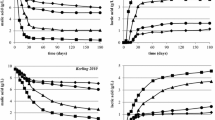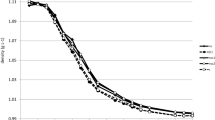Abstract
After the appearance of “Etudes sur le vin” by Pasteur, in enology lactic acid bacteria have been considered as deteriorating agents for more than 50 years. About 1920, Ferré in Burgundy and Ribéreau-Gayon in Bordeaux demonstrated the enological importance of the transformation of malic to lactic acid. This notion is now generally accepted in most vinicultural areas. Malolactic fermentation is encouraged, especially for red wines, for two reasons: a) it eliminates the taste of malic acid and lowers the acidity of the wine, b) it assures the biological stability of wines conserved with a minimum of sulphurous anhydride.
In traditional vinification, malolactic fermentation is the result of bacterial growth. It is spontaneous, that means induced by the endogenous lactic acid bacteria of grapes and winery equipment. In the must, yeasts and bacteria develop simultaneously; in the antagonism between yeasts and bacteria the bacterial population is more often becoming dominant than being suppressed. The grapes are sulphited so that bacterial growth occurs only after complete exhaustion of sugars by the yeasts. Consequently, alteration of the wine, as a result of sugar fermentation by the bacteria, is prevented. In a well-controlled vinification lactic acid bacteria can complete their growth cycle in the wine. Wine, however, is a poor culture medium and the bacteria multiply under restricted nutritional, physical and chemical conditions. As a consequence, malolactic fermentation is difficult to control in practice, in spite of all the research done for more than 30 years.
For a long time, one has tried to stimulate malolactic fermentation by inoculating wine with bacteria. Until now, the problem has been to determine the biomass of bacteria, sufficient for fermentation to take place as well as the quality required. The desired physiological state of the bacteria in the inoculum is also not known.
Similar content being viewed by others
References
Benda, I. 1982. Wine. p. 9–402. In G. Reed (ed.), Prescott and Dunn's Industrial Microbiology, 4th edition. — AVI Publ. Co., Westport, C. T.
Carre, E. 1982. Recherche sur la croissance des bactéries lactiques en vinification. Désacidification biologique des vins. — Thèse de 3ème cycle. Université Bordeaux.
Chalfan, Y., Goldberg, I. and Mateles, R. I. 1977. Isolation and characterization of malo-lactic bacteria from Israeli red wines. — J. Food Sci. 42, 939–943.
Costello, P. J., Morrison, G. J., Lee, T. H. and Fleet, G. H. 1983. Numbers and species of lactic acid bacteria in wine during vinification. — Food Technol. Austr. 35, 14–18.
Divies, C. and Siess, M. H. 1976. Etude du catabolisme de l'acide l-malique par Lactobacillus casei emprisonné dans un gel de poly-acrylamide. — Ann. Microbiol. (Inst. Pasteur) 127B, 525–539.
Gallander, J. F. 1979. Effect of time of bacterial inoculation on the stimulation of malolactic fermentation. — Am. J. Enol. Vitic. 30, 157–159.
Kunkee, R. E. 1967. Malo-lactic fermentation. — Adv. Appl. Microbiol. 9, 235–279.
Lafon-Lafourcade, S. and Joyeux, A. 1979. Techniques simplifiées pour le dénombrement et l'identification des microorganismes vivants dans les moûts et les vins. — Conn. Vigne Vin 13, 295–310.
Lonvaud-Funel, A. and Strasser de Saad, A. M. 1982. Purification and properties of a malolactic enzyme from a strain of Leuconostoc mesenteroides isolated from grapes. — Appl. Environ. Microbiol. 43, 357–361.
Maret, R. and Sozzi, T. 1977. Flore malolactique de moûts et de vins du canton du Valais (Suisse). I. Lactobacilles et pédiocoques. — Ann. Technol. Agric. 27, 255–273.
Maret, R. and Sozzi, T. 1979. Flore malolactique de moûts et de vins du canton du Valais (Suisse). II. Evolution des populations de lactobacilles et de pédiocoques au cours de la vinification d'un vin blanc (Fendant) et d'un vin rouge (Dôle). — Ann. Technol. Agric. 28, 31–40.
Maret, R., Sozzi, T. and Schellenberg, D. 1979. Flore malolactique de moûts et de vins du canton du Valais (Suisse). III. Les leuconostocs. — Ann. Technol. Agric. 28, 41–55.
Pan, C. S., Fleet, G. H., Morrison, G. J., Costello, P. J. and Lee, T. H. 1980. Isolation and identification of lactic acid bacteria from Australian wines. — Annual Meeting, Am. Soc. Vitic. Enol., Los Angeles.
Ribéreau-Gayon, J., Peynaud, E., Ribéreau-Gayon, P. and Sudraud, P. 1975. Sciences et techniques du vin, Tome 2. Caractères des vins. Maturation du raisin. Levures et bactéries. — Dunod éd., Paris.
Author information
Authors and Affiliations
Rights and permissions
About this article
Cite this article
Lafon-Lafourcade, S., Lonvaud-Funel, A. & Carre, E. Lactic acid bacteria of wines: stimulation of growth and malolactic fermentation. Antonie van Leeuwenhoek 49, 349–352 (1983). https://doi.org/10.1007/BF00399509
Issue Date:
DOI: https://doi.org/10.1007/BF00399509




